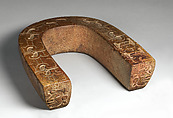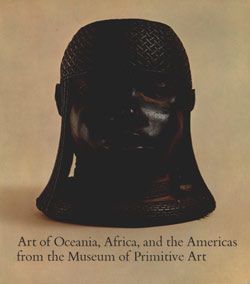Yoke
Not on view
Sculpted and painted images of the Mesoamerican ballgame show players wearing several items of protective gear, including some form of padding around their torsos to lessen the impact of the heavy rubber ball. While stone examples such as this one, called yokes, are unlikely to have been worn during the actual playing of the game, they are often depicted in scenes of ballgame-related rituals (Koontz 2009, figure 3.8).
Both open and closed yokes are known, some undecorated and others covered in figural or abstract motifs (see MMA 69.237, 1978.412.15). Only the top surface of this open yoke is covered with a continuous design of interlocking scrolls created in low relief and incising. All other surfaces have been left plain. Such scroll designs are most closely associated with the art of Classic-period Veracruz, where they were widely used to decorate stone sculpture and architecture.
The open edges of this yoke depict human faces in profile facing outward. They wear the large earspools associated with high status in Mesoamerica, their hair tied into an elaborate knotted design. Ballplayers depicted on a covered bowl from South Central Veracruz are similarly adorned (see MMA 2002.458a, b), suggesting that these faces are those of ballplayers as well. Their closed eyes may indicate that they are dead, most likely victims of post-ballgame ritual decapitations.
Most scholars now believe that yokes and other ballgame regalia made of stone (see MMA1979.206.371, 1979.206.425) could not have been worn by players actively engaged in the game. There are no holes or notches that could have been used to affix them to each other, and their weight alone would have made it nearly impossible for them to remain in place on the body. Indeed, it has been suggested that, when hit by the heavy ball, stone yokes could have caused greater injury to the wearer than a direct hit by the ball. Stone yokes such as this example were most likely reserved for ceremonial use, given as trophies, or placed as funerary offerings, while lighter-weight versions, made of perishable materials such as cloth, wood, or leather, would have been worn during the game.
Patricia J. Sarro, 2022
Resources and additional reading
Ceremonial Sculpture of Veracruz. New York: Long Island University, 1987.
Earley, Caitlin C. "Stone Sculpture and Ritual Impersonation in Classic Veracruz." Metropolitan Museum Journal (2019), pp. 8-25, fig. 5.
Ekholm, Gordon F. "The Probable Use of Mexican Stone Yokes." American Anthropologist 48:4, pp. 593-606, 1946.
Koontz, Rex. Lightning Gods and Feathered Serpents: The Public Sculpture of El Tajín. Austin: University of Texas Press, 2009.
Leyenaar, Ted J.J. Ulama, Jeu de Balle des Olmeques aux Azteques - Ballgame, from the Olmecs to the Aztecs. Lausanne: Musée Olympique, 1997.
Proskouriakoff, Tatiana. "Classic Art of Central Veracruz. In Handbook of the Middle American Indians, edited by Gordon F. Ekholm and Ignacio Bernal, vol. 11, pp. 558-571. Austin: University of Texas Press, 1971.
Reents-Budet, Dorie (ED.) Painting the Maya Universe: Royal Ceramics of the Classic Period. Durham, N.C.: Duke University Press, 1994.
Scott, John F. "Dressed to Kill: Stone Regalia of the Mesoamerican Ballgame." In The Sport of Life and Death, The Mesoamerican Ballgame, edited by E. Michael Whittington, pp. 50-63. New York: Thames and Hudson, 2001.
Shook, Edwin M. and Elayne Marquis. Secrets in Stone: Yokes, Hachas and Palmas from Southern Mesoamerica. Philadelphia: American Philosophical Society, 1996.
Thompson, J. Eric. "Yokes or Ballgame Belts?" American Antiquity 6:4, pp. 320-326, 1941.
Whittington, E. Michael, ed. The Sport of Life and Death: The Mesoamerican Ballgame. New York: Thames and Hudson, 2001.
Wilkerson, S. Jeffrey K. "Un yugo ‘en situ’ de la región del Tajín." Boletín 41:41-45. Mexico City: Instituto Nacional de Antropología e Historia, 1970.
This image cannot be enlarged, viewed at full screen, or downloaded.


